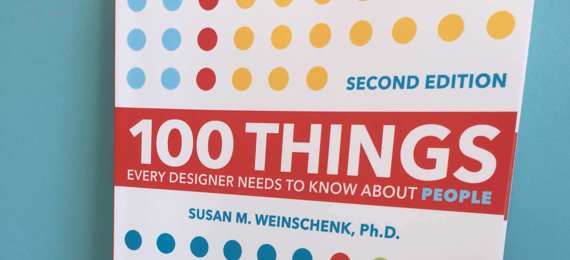
While looking for a little light holiday reading in the vague realm of user-centred / UX design, I came upon this book by Susan M. Weinschenk, Ph.D. Not the most recent (originally published in 2011), but reassuringly listed in several ‘best books in . . . ’ searches. Having flicked through the online ‘Look Inside’ summary, the first line of the introduction instantly resonated with me:
This book is hugely relevant for anyone interested in the basic psychology of design and how it influences and impacts peoples’ perceptions, motivations, decision-making, behaviours and actions.
Evidenced examples, engagingly presented
The book introduces 100 key design principles (I’ll refer to them as principles, although they are really a mixture of theories, guidelines and explanations or as the author calls them ‘things’), drawn from a wealth of behavioural science and applied psychology. These individual principles are broken down into 10 chapters, from ‘How people see’ to ‘How people decide’. Each is succinctly and engagingly presented in 1-2 pages, typically introduced with a practical, real-world example or highly relatable story, with further explanations reinforced with key academic references, rich imagery and insightful takeaways.
My approach to the book was to select a particular chapter of interest e.g. ‘What motivates people’ and then read through each principle (don’t like to miss stuff).
That said, many of the principles are interrelated and these overlaps and connections are highlighted throughout.
Rewards, human faces and mental models
The book covers a huge diversity of directly applicable principles, but one I particularly like relates to how we design for and understand people's responses to positive reinforcement:
Number 51 - Variable Rewards are Powerful
This principle outlines how behaviour can either be increased or decreased based on how often and in what way a reward (reinforcement) is given. This principle is underpinned by the work of B.F. Skinner on ‘operant conditioning’.
The basic premise is that if a rat gets a food pellet whenever it presses a bar, that behaviour is conditioned through positive reinforcement. Then, if the frequency with which the pellet is given is manipulated, either based on time (i.e. the rat gets a pellet the first time he presses the bar after every 5 minute interval) or a number of bar presses (i.e. the rat gets a pellet on every 5th press of the bar), the rat’s behaviour will change to secure the food.
It's not rocket science you may say, but it gets a bit more interesting when you add in variability, so the timing of the pellet being given or the number of bar presses feels more random (although still within a defined range). This sense of unpredictability increases engagement, particularly when you don't know when the reward will be given, but you know the more you ‘press’ the greater your chances.
Other interesting principles (Number 47) include the fact that people will typically focus on designs that involve food, sex or danger (based upon our intrinsic desire to survive), but human faces (Number 4) are also deeply engaging and will capture attention.
The book also describes how we create mental models, their value and how they differ/relate to conceptual models (Number 31 and 32); that peoples' optimum time of sustained attention is 7-10 minutes (Number 44); that people's memory of categories (Number 34) relates to how well they are organised (and make sense), not to who created them, even if you created them yourself!
Bit basic or basic background?
Whilst the majority of principles were very insightful, introducing both new ideas and refreshing others, equally, some felt possibly a little basic. Principle Number 34 describes how people learn best by example and suggests using pictures, screenshots or videos to show this. For most designers and researchers this may feel rather obvious (possibly a little condescending), as it could be said many of the principles relate to approaches that these professionals apply routinely, intuitively and often subconsciously. That said, I still think there is great value in understanding the background or research behind many of these principles:
- why is it better to chunk information?
- when do you provide defaults (and when not)?
- how does proximity enhance connections etc.
Further reading
For those that love a design principle (and in conjunction with this book), I would also highly recommend reading ‘Universal Principles of Design’ by Lidwell, Holden and Butler. Rather than organising the principles according to the mechanisms by which people receive, process and respond to information (and design), this book instead lists each principle from A - Z. As such it works really well as a resource to further expand and clarify many of the principles outlined above.
Weinschenk has released a newer edition (2015) of her book titled ‘100 More Things a Designer Needs to Know About People’, which includes a diversity of new principles, many organised under revised (and potentially more relevant) chapters such as ‘How people interact with interfaces and devices’ and ‘How people's bodies affect design’.
100 Things Every Designer Needs to Know about People by Susan M. Weinschenk



